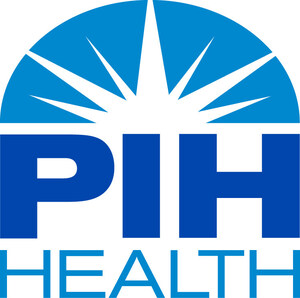LOS ANGELES, Aug. 10, 2020 /PRNewswire/ -- PIH Health Good Samaritan Hospital is one of the first hospitals in Los Angeles to offer the next-generation Watchman FLX™ Left Atrial Appendage Closure (LAAC) implant to patients with non-valvular atrial fibrillation (AF). The implant is an alternative to long-term warfarin medication.
Up to 6 million Americans are estimated to be affected by AF – an irregular heartbeat that feels like a quivering heart.i According to the National Stroke Association, people with AF have five times greater risk of stroke than those with normal heart rhythm.ii The WATCHMAN FLX device closes off an area of the heart called the left atrial appendage (LAA) to keep harmful blood clots that can form in the LAA from entering the blood stream and potentially causing a stroke. By closing off the LAA, the risk of stroke may be reduced and, over time, patients may be able to stop taking their blood thinner, such as warfarin. The next-generation technology has a new design to help treat more patients safely and effectively to ensure the best long-term outcomes.
"The new Watchman FLX implant is a breakthrough treatment," said Steven Burstein, MD, medical director of the Cardiac Catheterization Laboratories at PIH Health Good Samaritan Hospital. "For patients with non-valvular a-fib who are in need of an alternative to warfarin, the implant offers a potentially life-changing stroke risk treatment option that could free them from the challenges of long-term warfarin therapy."
The WATCHMAN technology has been implanted in more than 100,000 patients worldwide and is done in a one-time procedure. It is a permanent device that does not have to be replaced and cannot be seen outside the body. The procedure is done under general anesthesia and takes about an hour. Patients commonly stay in the hospital overnight and leave the next day.
About Atrial Fibrillation
Atrial fibrillation (AF) is a heart condition where the upper chambers of the heart (atrium) beat too fast and with irregular rhythm (fibrillation). AF is the most common cardiac arrhythmia, currently affecting up to 6 million Americans. i,iii Stroke is the most common complication of AF, and AF-related strokes are also more frequently fatal and disabling.iv,v In people with non-valvular AF, more than 90 percent of all stroke-causing clots that come from the heart form in the LAA.vi The most common treatment to reduce stroke risk in patients with AF is blood-thinning medication, such as warfarin. While very effective at reducing the risk of stroke, blood thinners increase the risk of serious bleeding overtime and come with certain requirements and restrictions.
For more information on the WATCHMAN FLX device, please visit: www.watchman.com.
About PIH Health
PIH Health is a nonprofit, regional healthcare network that serves approximately 3 million residents in the Los Angeles County, Orange County and San Gabriel Valley region. The fully integrated network is comprised of PIH Health Downey Hospital, PIH Health Good Samaritan Hospital, PIH Health Whittier Hospital, 27 outpatient medical office buildings, a multispecialty medical (physician) group, home healthcare services and hospice care, as well as heart, cancer, digestive health, orthopedics, women's health, urgent care and emergency services. The organization is recognized by Watson Health as one of the nation's Top Hospitals, and College of Healthcare Information Management Executives (CHIME) as one of the nation's top hospital systems for best practices, cutting-edge advancements, quality of care and healthcare technology. For more information, visit PIHHealth.org or follow us on Facebook, Twitter, or Instagram.
i Benjamin EJ, Muntner P, Alonso A, et al. Heart disease and stroke statistics—2019 update: a report from the American Heart Association. Circulation. 2019;137:e1-e473.
ii National Stroke Association. Making the Afib-Stroke Connection. https://www.stroke.org/sites/default/files/resources/Afib-Connection%20for%20hcp.pdf. Published 2012. Accessed September 1, 2016.
iii "Atrial Fibrillation Fact Sheet." Centers for Disease Control and Prevention. https://www.cdc.gov/heartdisease/atrial_fibrillation.htm.
iv Hart RG, Halperin JL., Ann Intern Med. 1999; 131:688–695.
v McGrath ER, Neurology 2013; 81:825-832.
vi Price MJ, Reddy VY, Valderrábano M, et al. Bleeding outcomes after left atrial appendage closure compared with long-term warfarin. JACC Cardiovasc Interv. 2015;8(15):1925-1932.
SOURCE PIH Health

Related Links
WANT YOUR COMPANY'S NEWS FEATURED ON PRNEWSWIRE.COM?
Newsrooms &
Influencers
Digital Media
Outlets
Journalists
Opted In





Share this article